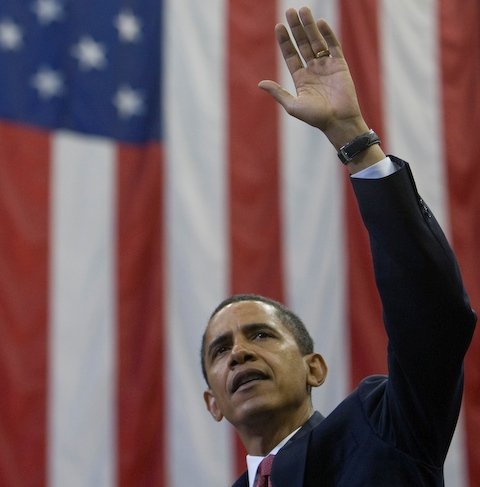by David Steven | May 6, 2010 | Climate and resource scarcity, North America
In the run up to Copenhagen, I suggested the economic downturn could be used to push for a goal of an immediate peak to global emissions.
In a pastiche of Kennedy’s man on the moon speech, I imagined President Obama laying down the following gauntlet to the world:
I believe that the world should commit itself to achieving the goal of stopping the inexorable rise in greenhouse gas emissions that is doing so much to put our planet in peril. I don’t believe we should aim to achieve this goal in 2020 or 2030 or 2050 – but right now in 2009, making this year the high water mark for mankind’s global experiment with the global climate.
Obviously this didn’t happen, but – gradually – we’re learning more about has happened to emissions. The figures for US carbon dioxide for 2009 are now in and the good news is that they fell by an astonishing 9%.
Question is: has the US stimulus been wisely spent on measures that will push the economy onto a lower carbon path as it grows again? The answer is probably not, though there is some reason for hope:
As the economy recovers, the structure of that recovery will be important to the future emissions profile of the United States. If energy-intensive industries lead the economic recovery, emissions would increase faster than if service industries or light manufacturing play the leading role. If coal, which was more heavily impacted by the recent economic downturn than other energy sources, rebounds disproportionately, the carbon intensity of the energy supply could rise above the 2009 level.
However, longer-term trends continue to suggest decline in both the amount of energy used per unit of economic output and the carbon intensity of our energy supply, which both work to restrain emissions.
The world is at a major inflection point on its carbon trajectory, but I fear we’re going to blunder through it without realising the opportunity for transformation. As Copenhagen showed, unfortunately, we’re still a long, long way from reframing climate change as a now problem. But it’s still not too late to start working for peak emissions.
by Alex Evans | Dec 6, 2009 | Climate and resource scarcity, Global system, Influence and networks
As we’ve been arguing here since March, the year that policymakers select as the deadline for global emissions must peak is the key short-term variable to watch at Copenhagen. So what is the deadline, assuming we want to limit global average warming to 2 degrees C?
Well, David and I would like to see policymakers agree that emissions should peak right now, given that emissions have fallen so much as a result of the credit crunch. The development NGOs who are most active on climate change – Oxfam, Christian Aid and Tearfund, as well as Avaaz – are a little more cautious than that, arguing that emissions should peak by 2015; but they’re still basically on the same page as the IPCC, which said in its last Assessment Report (pdf – see table at the foot of page 15) that to limit global average warming between 2.0 and 2.4 degrees Celsius, global emissions must peak between 2000 and 2015. Chair of the IPCC Rajendra Pachauri has also said that 2015 is the deadline.
Astonishingly, though, the main federation of environmental NGOs – the Climate Action Network – says that any time up to 2017 is fine. WWF International agree. TckTckTck used to say 2017 too (as I noted when they published their policy position); they’ve subsequently revised their target to 2015, but still have documents on their website using the old date. (Nothing like a consistent message, eh?)
Be very clear: this isn’t just hair-splitting. Once the peak date for emissions slides beyond 2015 and towards 2020, according to the IPCC, we’re heading for a world that’s not 2.0-2.4 degrees C warmer, but 2.4-2.8 degrees C. That is what the environmental NGOs are arguing for. Shortly before they spend a fortnight calling everyone else at the Copenhagen summit “fossil of the day“. It’s breathtaking.
So, if you can’t make it to the summit but still want a way to take action and make your voice heard ahead of Copenhagen, how about this. First thing on Monday, get in touch with any environmental NGOs you support. Ask them their position on the global peak emissions date. And if it’s any later than 2015, then cancel your subscription.
I’m not kidding. Policymakers aren’t the only ones at Copenhagen who need to be held to account. If the green NGOs can’t get their figures right on something this fundamental, this basic (even as the development NGOs manage it just fine) then they need to – what’s that phrase from the Bali summit? – “leave it to the rest of us; please, get out of the way“.
by David Steven | Jun 15, 2009 | Climate and resource scarcity, North America
US climate envoy, Todd Stern has tried to clarify exactly what the Obama administration wants from China on climate at Copenhagen (see post from Leo and me on the confusing signals the US has been sending out).
So here it is:
- “Very considerable” reductions on China’s business as usual emissions.
- These reductions to be binding, transparently measured and verifiable.
- No absolute emissions reductions but (preferably at least) a designated year when China’s emissions should peak.
- China’s commitment to be consistent with the world stabilising its emissions at around 450 ppm (“we don’t know whether it’s 445 or 460 or… but in that general range”).
- The package to be backed up by carbon offsets from the US to China – but these offsets should have “real environmental integrity” – and technology cooperation.
Obvious questions to ask Stern –
- Do you believe that President Obama’s domestic commitments on climate are consistent with a 450ppm stabilization target?
- Will the United States be pushing for a 450ppm target to be enshrined in the Copenhagen agreement?
- When does the United States think Chinese emissions should peak to meet 450ppm?
- When does the United States expect global emissions to peak?
by David Steven | Mar 5, 2009 | Climate and resource scarcity, North America

Yesterday, I put some words into Barack Obama’s mouth – re-jigging JFK’s famous ‘man on the moon’ speech as a call for an immediate peak to global emissions.
Setting a goal that emissions should never rise again, is something I have argued we should do now, rather than hoping we’ll simply be braver or more desperate in five or ten years’ time.
Originally, I suggested this should be a major plank for civil society campaigning – and I still think it should be. But governments can play too. Let’s look at the policy from vantage point of the Obama administration. (more…)
by David Steven | Mar 4, 2009 | Climate and resource scarcity, North America

Extracts From Special Message to the Congress on Urgent National Needs
President Barack Obama
Delivered in person before a joint session of Congress
May 25, 2009
[With apologies to JFK’s ‘man on the moon‘ speech.]
The Constitution imposes upon me the obligation to “from time to time give to the Congress information of the State of the Union.” While this has traditionally been interpreted as an annual affair, this tradition has been broken in extraordinary times.
These are extraordinary times. And we face extraordinary challenges… [The President’s discussion of economic, security and resource threats has been cut from this transcript.]
…Finally, if we are to win the battle to secure our shared future, then we must act decisively to stabilize the world’s climate. Otherwise, we will begin to suffer the consequences of our folly within a generation – not just at home, but across the world, as we struggle to sustain security and prosperity on an increasingly crowded planet.
Since early in my term, serious efforts to tackle climate change here in America have begun. We have examined where we are strong, and where we are not, where we may succeed and where we may not. Now it is time to lead the world in a great new enterprise, one which will hold the key to our future on earth.
I believe we possess all the resources and talents necessary. But the facts of the matter are that we have never made the international decisions or marshaled the international resources required for such leadership. We have never before specified long-range goals on an urgent time schedule, or managed our resources and our time so as to insure their fulfillment.
I therefore believe we should set these global and national goals.
First, I believe that the world should commit itself to achieving the goal of stopping the inexorable rise in greenhouse gas emissions that is doing so much to put our planet in peril. I don’t believe we should aim to achieve this goal in 2020 or 2030 or 2050 – but right now in 2009, making this year the high water mark for mankind’s global experiment with the global climate.
Second, once we have bought emissions to a standstill, we should aim to force them down year by year – slowly at first, but at an ever increasing pace, triggering a radical transformation that brings us to a near zero carbon world by mid-century.
(more…)


